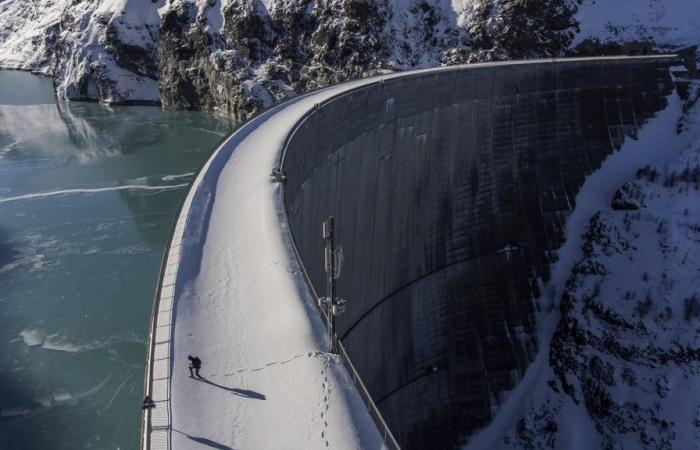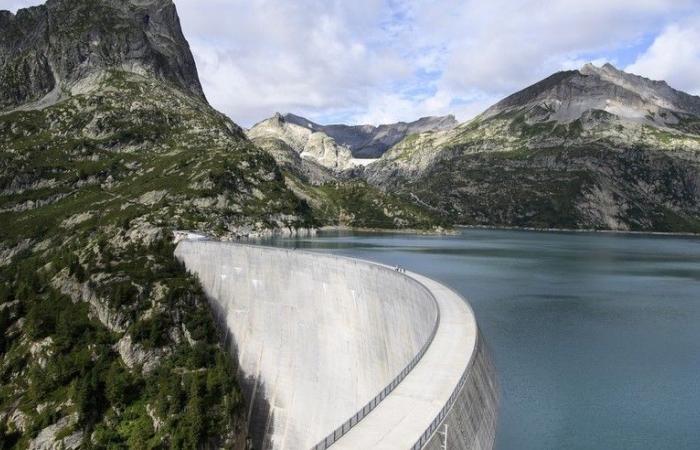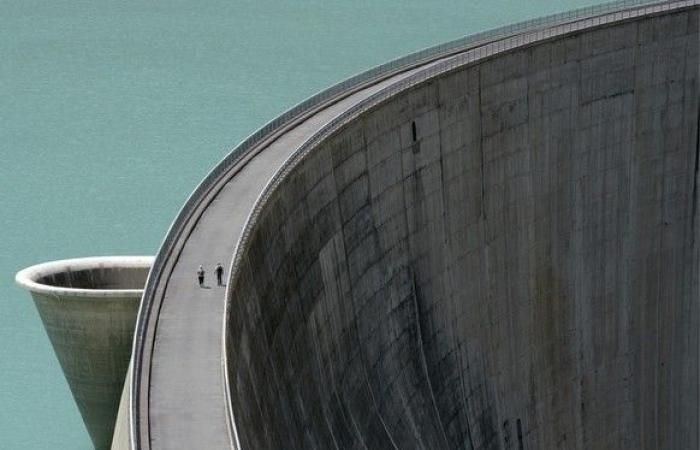Image: KEYSTONE
Plans to address the 2.2 terawatt winter electricity shortage are not working. Raising the dams in Valais and the canton of Graubünden by 20 meters poses problems.
Christian Bernhart / ch media
Attention was mainly focused on the environment when the round table chaired by Federal Councilor Simonetta Sommaruga agreed in December 2021 on 15 hydroelectric projects intended to make up for the electricity shortage in winter. But in addition to environmental associations, the Swiss hydraulic economy, chaired at the time by Albert Rösti, also supported the projects. And on the side of the hydraulic power plant operators, the boss of Axpo, Christoph Brand, put his signature on the document. The project plans to fill the winter electricity shortage of 2.2 TWh per year by 2040 by increasing the height of existing dams.
But reliable information was lacking on the possibility of raising the so-called double-arch dams with vertical and horizontal curvature by 20 meters. This is what emerges from secret documents made public by Infosperber in January 2023.
The projects concerned are:
- The Grisons dams of corner (+20 m) and Nalps (+25 m).
- The dam of Moira (+22 m) in Valais.
- The Lake Toules in Bourg-Saint-Pierre (VS), whose wall should even be raised by 32 meters.
Lake Toules in Bourg-Saint-Pierre (VS).Image: Keystone
The documents do not contain revealing drafts. Only preliminary studies are available, at most those which cover the services for civil engineering work fees. Already a year ago, Alpiq’s head of construction, Jonathan Fauriel, announced his skepticism about Moiry’s project from Alpiq in an interview with the German science magazine Image of science. Fauriel described the project as “very complicated and very expensive”car:
“The wall must be dismantled to adapt its geometry”
All the geometry of the dam change
Fauriel’s knowledge is based on his experience in the Gruner company of dam pioneer Alfred Stucky, who in 1921 designed and built Europe’s first double-arch dam for Lake Montsalvens in Gruyère. In these elegant dams, the route of the arches is exactly aligned with the cut of the valley, in the rock structure of which the wall is anchored watertight. The geometry means that a construction of more than ten meters is either impossible or extremely expensive.
An elevation of 20 meters with an increasing water level would modify and greatly increase the pressure on such a wall, which would require adaptation of the geometry of the wall. For this, the upper third of the wall must be deconstructed. Deconstruction is delicate and above all costly, because shaking must be avoided. There is no question of using drills or explosives. As Gruner engineer Alexandre Wohnlich explained in 2021 in a specialist article on the raising of the old Emosson dam, it was first necessary to empty the lake and delicately mill 20 meters of the concrete wall at the using a plane. The connection between the new and old walls was also tricky, as there was a 60-year difference between the old and new. Steel bolts had to be used to ensure proper connection.
If there is no rock on the side, it becomes laborious
However, stable rocks to raise the arched wall by more than 20 meters are lacking at the Moiry (VS), Toules (VS) and Nalps (GR) dams. As this anchorage was missing on the right side of the valley of the old Emosson dam, it was necessary to build a massive gravity dam to ensure its stability. This is one of the reasons why the actual construction work, without filling the emptied lake, lasted five years (2012 to 2016), knowing that at an altitude of 2,230 meters, the work could not take place. only from April to October.

The Emosson dam.Image: KEYSTONE
A year ago, in April, the Federal Office of Energy (SFOE) informed the Committee on the Environment, Spatial Planning and Energy of the Council of States (CEATE-E) of the progress of the 15 projects of the round table by indicating that, for technical reasons, Axpo had to reduce by more than half the 99 GWh per year announced for Nalps and Curnera (GR), i.e. 50 GWh, and that it was necessary still determine whether the Lac-les-Toules project was technically feasible. As for the Moiry project, Alpiq spokesperson Guido Lichtensteiger said today:
“The final height has not yet been fixed, it will perhaps be less than 20m”

The Moiry dam.Image: KEYSTONE
Critical comments on the increase in projects are also made by an engineer familiar with dams. As the companies Lombardi and Gruner have made a name for themselves with such projects, he wishes to remain anonymous. Concerning the Lac les Toules project, whose wall was reinforced between 2008 and 2011, he declares:
“Everyone who knows the dam knows that it is impossible to raise it for technical and geometric reasons”
Regarding the Moiry project, our source indicates that an elevation of only 8 to 9 meters is planned. As for the Nalps dam, not only there is no possible anchoring in the rock on one side, but with a wall height of 127 meters, an elevation of 20 meters is very daring.

The Nalps dam.Keystone
Reservations regarding the 20 meter raises are also shared by Giovanni De Cesare, lecturer in hydraulics at EPFL, because “mainly, the double arch dams are anchored on both sides in the rock structure, which must withstand pressure during elevation. Regarding the shape, De Cesare believes that “the geometry of the double arches can possibly be adapted.
But this is not always possible, because the wall becomes thinner towards the top. Otherwise, the upper part of the wall must be dismantled, but this also depends on the geometry and quality of the existing concrete wall. The lake would then have to be partially or completely drained if the turbines cannot continue to operate in parallel.
L’extension depends on subsidies
These four projects (Nalps, Curnera, Moiry, Toules), which must contribute to covering winter electricity with around 300 GWh per year, are therefore either stalemates or dependent on massive subsidies for electricity production which is stopped for ten years.
This doesn’t worry the Urek-E. Its president, the Valais State Councilor Beat Rieder, affirms that other projects were in fact presented during the round table and above all that “the adoption of the law on electricity for the promotion of renewable energies allows the Council federal government to implement other projects.
This week, the Walliser Bote announced that the canton of Valais wants to build new reservoir lakes in addition to the extension decided for 2022: among them, the Oberaletsch project with 765 gigawatt hours per year. The Burgsee Fieschergletscher, Arolla, Dix+ and Gletsch Grimselsee dams are also among the largest projects.
The adoption of this electricity law also has repercussions on Axpo’s Nalps and Curnera projects. Its spokesperson, Martin Stutz, says that we must first wait and analyze the final ordinances of the Electricity Promotion Act.
It is therefore not certain that the 2.2 terawatts per year can one day be provided by elevated dams. Only Bernese projects could be ready on time. The request for raising the Grimsel dams by 20 meters is in progress and in the hands of the canton.
As a precaution, the geometry of the new Spitallamm wall has already been adapted for later elevation. For Trift, the dealership is available and detailed planning is underway. On the other hand, for the Nalps and Curnera dams, the canton of Graubünden will probably not be able to submit to the Confederation the energy master plan necessary for project planning before the end of the year.
(Translated and adapted by Chiara Lecca)










